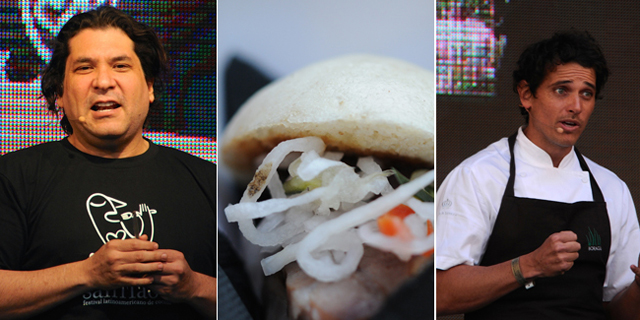From the 3rd to the 6th of April Ñam, the four
day Latin American food festival, held in Santiago Chile’s Lastarria
neighborhood, filled the amphitheater and plazas with foodies, wine-lovers,
chefs-in-training and the general public, looking for a tasty bite to eat.
Presenters included Alex Atala,Gastón
Acurio (top left, Astrid and Gastón), and Rodolfo Guzmán (top right, Boragó).
Also in attendance was the hometown, down-home
favorite Andrés Vallarino, whose homemade sausages are revolutionizing Chile’s
national comfort food, the completo at his restaurant called Hogs.
Vallarino shrugs off the label “gourmet,” saying it does not apply to their
food. He encourages people to try their hand at sausage making at home, and did
a demo on stage, from grinding, through seasoning, stuffing and cooking. He
handed out sample sandwiches at the end of his presentation.
“The taste of memory,” was the theme of the
4th annual iteration of Ñam. Acurio harkened back to his childhood, saying that
as a child, his father would take him to a nearby chifa (Chinese-Peruvian
restaurant) in Lima, and he dreamed that one day he would open one, himself,
which, after the great success of Astrid and Gastón, he did. Acurio gave
out siu mai, small dumplings-turned sandwiches, a fusion between
the Peruvian butifarra pork sandwich and chifa flavors, with zarsa criolla and
hoisin sauces, a touch of Peruvian rocoto pepper, and slices of cooked pork,
topped with a slaw of pickled turnip, served on a steamed bun, one of many
items found on his chifa’s menu.
According to Sol Fliman, whose Santiago
vegetarian restaurant Quinoa is
arguably the city’s best, “we all bring our memories to the table.” As a child
living out in the country, she brought dried fruits and nuts to school as a
snack, instead of mass-produced and packaged sweets. Eating close to the land
is her food culture, and the dishes she prepares at her restaurant exemplify
that. On stage, she prepared a salad with caramelized pears, toasted walnuts
and pomegranate seeds over a bed of mixed greens. The blue cheese on top, she
said, though not produced in Chile, is a guilty pleasure. The recipe is from
her cookbook Cocina de Mercado: Sabores Vegetarianos, which will be
representing Chile in the Gourmand World Cookbook Awards in Beijing this May.
Next, get a taste of Ñam…
[pagebreak]Many of the chefs touted making the most of
what the local environment has to offer. Fernando Rivarola, chef at Buenos
Aires’ much-lauded Baqueano talked about how despite having thousands of miles of coastline, Argentines
consume very little fish. He’d like to change that, and talked about how he
turns pacú, a fresh water fish indigenous to Argentina, into a type
of “ham.” And speaking of local (and overlooked) ingredients, Rodolfo Guzmán
prepared his dish of pan-wilted foraged purslane, wild mustard and purple sage
topped with strained kefir. His passion for the soil, he says, is what he tries
to transmit at his restaurant, Boragó which was voted 8th best in Latin
America.
Away from the talks, up at the Ñam market,
local producers of regional products had stands selling organic seeds, the
multi-hued potatoes of the large island of Chiloé and a relatively-unknown
sweet wine called Pajarete from the Huasco Valley in northern Chile, which has
been in production for 400 years. Also on hand were the producers of arrope
de chañar, a syrup made from a fruit found in the north of Chile. This was
for sale, and also incorporated into a dessert prepared by chefs-in-training
from Universidad de Las Americas at the market kitchen. They gave out samples
of the result, a sweetened dessert of quinoa and milk, similar to rice pudding,
with a small portion of chañar syrup at the bottom, and sprinkled with chopped
walnuts, which are also grown in the north of Chile.
By night, the market closed up, and the tapas
portion began. Unlike in other years, when the tapas have been made with
hard-to-find, short-lived ingredients, like the maqui fruit
and chupones, the edible fruit of a wild bromeliad, both from the
south of Chile, the tapas reflected this year’s theme and played upon the flavors
of childhood. There were empanadas de mechada (sliced meat,
rather than the traditional ground beef), porotos granados, pastel
de papa, and a fish soup called caldillo, with luche, a kind of
seaweed. The most unusual dish was a “ceviche” made of cochayuyo (bull kelp).
For dessert at the tapas bar there were a few
options, but the runaway winner was the cuchuflí (coo-choo-FLEE)
stand, where they were making them fresh. Cuchuflís are rolled wafers, filled
in this case with either a sweet papaya custard or vanilla cream. They are
usually filled with manjar, Chile’s version of dulce de
leche, and an arrangement of cuchuflís all standing up is
many Chilean children’s first birthday “cake,” ensuring that visitors to Ñam
ended their night with precisely what they came for: a taste of memory.
Next, get a taste of Ñam with Sol Filman’s Pear Salad recipe…
[pagebreak]- 3 pears
- 10 1/2 ounces mixed greens
- 1/2 cup toasted walnuts, broken in quarters
- seeds of 1 pomegranate
- 6 ounces blue cheese, crumbled
- 2 tablespoons unsalted butter
- 1 tablespoon mild-flavored oil


![Making Mealtime Matter with La Familia: Easy Sofrito [Video]](https://thelatinkitchen.com/wp-content/uploads/2015/10/sofrito-shutterstock__0-500x383.jpg)
![Easy Latin Smoothies: Goji Berry Smoothie [Video]](https://thelatinkitchen.com/wp-content/uploads/2015/12/goji_berry-shutterstock_-500x383.jpg)
















![Fun and Fast Recipes: Fiesta Cabbage Salad [Video]](https://thelatinkitchen.com/wp-content/uploads/2015/11/fiesta_cabbage_slaw-shutterstock_-500x383.jpg)









